| RHODES
Rhodes, the pearl of the Mediterranean as they call it, is a very interesting island not only
for it's natural beauty, but also for its archaeological treasures.
This page contains the following information:
General Information
Rhodes, the largest of the Dodecanese islands, is not an ordinary
holiday resort but a cosmopolitan place with an international reputation.
Indeed, this relatively limited space, endowed with innumerable
natural beauties, is rightly considered a tourists' paradise. Holidays here are not restricted to the three summer months, as the sunny period lasts much longer.
In Rhodes everyone can choose their preferred type of holiday -- the
intensity of an excellently equipped major resort or the peace and
quiet of a small, traditional seaside or mountain village. Swimming in the crystal-clear waters of Rhodes is equally fascinating on populous beaches or on isolated pebbled seashores.
Lovers of history will be drawn to the remarkable monuments all over
the island, signs of its long history. Those who prefer mobility will find an adequate network of roads enabling them to reach almost every corner of the island. Daily air
and sea communications with other islands, numerous tourist agencies open limitless horizons to the traveller.
Given its present reality, Rhodes would resemble a rose (rhodon in Greek) rather than the mythical nymph after whom the island was allegedly named.
Transportation
From Athens there are quite a few flights every day.The duration of the flight is 55 minutes. For more information contact Olympic Airways in Athens tel. (01) 9666666 or
Olympic Airways in Rhodes tel. (0241) 24.555. Also by plane from Thessaloniki there are 2-3 flights a week during the whole year. The duration of the flight is 1 hour and 10 min. For more information contact Olympic Airways in Thessaloniki tel. (031) 260.
1219.
Rhodes is 260 nautical miles from Piraeus. From Piraeus there are daily ferries to Rhodes during the summer (duration: 19hours). For more information contact the Coastguard of Piraeus tel. (01) 4226000-4. For information about local connections from Rhodes, contact Olympic Airways in Rhodes tel. (0241) 24.555 (for flights) and the Coastguard of Rhodes tel. (0241) 27690.
Useful telephone numbers
Automatic dialing code: 0241
Port Authority: 28888
Police Station: 27423
Town Hall: 35945
First Aid: 25555
Greek National Tourist Office: 23555
Beaches
Kalithea, Faliraki, Afantou, Kolimbia, Tsambika, Agia Agathi, Haraki and Plimmiri
are some of the beautiful beaches of Rhodes.
Sports
Windsurfing is a popular sport. If you don't have a surfboard, you can rent one on the island. Also you can join tennis, golf and all water sports like water-skiing.
Night Life
Everything you could ask for is here. Discos, bars, pubs and a
Casino, all do their best to give you a great time.
Sailing Info
Mantraki: Excellent shelter. Fuel and water on quay. Night life.
Lindos: Good shelter. Anchored off. No fuel. Water in town. Night life.
Langonia: Poor shelter. Anchored off. Fuel and water in town. Taverns.
Halki: Good shelter. No fuel. Water in town. Taverns.
Back to the top
History
Strategically placed, the island has had a tumultuous past linked to the sea.
Rhodes was already inhabited in prehistoric times. The island gradually
expanded its influence and became the main commercial link in the
Mediterranean.
In 408 BC the island's three important Doric cities, Ialissos, Lindos and Kamiros,
united to found the city of Rhodes on the island's northeastern edge. This
marked a new era in the history of the island.
The Sun-worshipping city of
Rhodes became an important political, commercial and religious
centre. Its golden era lasted from the 5th to the 3rd century BC.
Rhodes extended its rule, minted its own coins, introduced the first maritime law
rules, advanced the arts, theatre and sports. Its School of Rhetoric became
famous and attracted many well-known Romans and Greeks.
In the 2nd century BC Rhodes became an ally of Rome. This led to a gradual weakening of
the island, which from the 2nd century AD became a Roman prefecture.
St Paul visited the island and recruited the first Christians in 57 AD. When the Roman Empire split in 395 AD, Rhodes and the other islands of the "Provincia
insularum" were included in the Byzantine Empire.
New seafarers attacked and often looted the city in the following centuries.
The Knights of the Order of St. John were established in Rhodes in 1309.
Their stay has endowed the city with a series of majestic buildings protected by
a fortified wall. From 1522 onwards the Dodecanese islands formed part of the Ottoman Empire until, in 1912 , they fell under Italian rule. The Treaty of Paris ended
foreign occupation, and in March 1948 the islands were united with Greece.
Back to the top
THE CITY
Present-day Rhodes is a medieval/modern amalgam which impresses and fascinates visitors. Its medieval aspect, fortified behind an impressive wall, merges harmoniously with the refined, cosmopolitan air of a modern resort with
luxurious hotels, broad avenues with rows of trees, and rich commercial stores.
The old town
It's fascinating to walk in the medieval town, full of impressive 15th-century buildings,
stone-paved lanes with arches and vaults, rows of little shops -- as a modern touch to the medieval picture -- offering a surprising variety of commodities.
Perhaps the best starting-point for a journey through medieval Rhodes is the wall
(14th century and 5 km long).
As we cross one of the most famous gates, Pili Eleftherias (Freedom Gate)
we encounter traces of the Temple of Venus (3rd century BC), also the
Inn of the Auvergne Knights, the Arsenal, the Museum of Decorative Arts
(folklore exhibits from the Dodecanese islands),
the Byzantine Museum (in a 13th-century church), and the majestic Harbour Gate
.
The Archaeological Museum (tel. 0241/27.674), housed in the 15th-century building
of the Knights' Hospital, includes collections of coins, pots and sculptures from the
Mycenaean up to the Roman era. We note the kneeling Venus of Rhodes (1st century AD)
and the sepulchral column of Tymarista and Crito.
The Knights' Road, official street of the medieval city, follows the ancient road
to the end (the Acropolis) but to the Palace of the Grand Masters.
Along the road lay the Inns of the Knights of Seven Languages, of which four
still remain.
The Palace of the Grand Masters or Knights' Palace (14th c.)
is a palace and fortress that dominates the old town. It was destroyed in 1856 and rebuilt in 1939. Floors are covered with ancient mosaics from the island of Cos.
There is an interesting collection of 16th and 17th-century Western furniture, and an
impressive arcade used as a place for meetings and as a majestic entrance.
The Palace has been renovated and is used to house important international functions.
Other remarkable sights in the old town are the Mosque of Suleiman, an old church
with a beautiful Italian door, the Castellania (16th-
century building now housing the Library) with its beautiful fountain,
St Catherine's Hospital,
the Admiralty Palace to its right, and finally the Folk Dance Theatre
working to preserve traditional music, dances and costumes in their purest form.
The new town
On entering Mandraki (yacht harbour), the most picturesque of the three
ports of the city, we are welcomed by two bronze deer. Erected where probably
the famous Colossus of Rhodes used to stand, they have become the modern
emblem of the town.
Nearby on the mole stands the lighthouse tower of St. Nicholas
and the three old colourful windmills.
Numerous monumental buildings surround Mandraki and add to its majestic air - among
others the New Market (Nea Agora), a polygonal building with internal
courtyard, the Archbishop's Palace, the Evangelismos
(Annunciation) church, the Central Post Office,
Town Hall, Theatre and Government-House (Italian-period
building now used as Prefecture) all four impressive buildings along the pier.
At the north end of the town stands the Institute of Marine Biology (Aquarium).
The ancient city
Although ancient Rhodes was a large city relatively few ruins have been found.
The ancient Acropolis stood on the eastern side of the Monte Smith hill, overlooking the city. Further on, one sees the Stadium (3rd century BC) and the curiously square sized Odeum (both rebuilt).
Performances of ancient drama are held every summer in the Odeum.
There are also a few ruins of the temples of Polias Athena, Pythian Apollo and
Zeus.
Sights near the city
Only 3 km from the city lies the luscious greenery of Rodini Park, with lots of
flower-gardens, picturesque lanes and ponds. From Rodini one can visit the Tomb of the Ptolemies and the ruins of a
Roman aquaduct.
Back to the top
East Coast
Most visitors to the island's east coast flock to Lindos (47 km from the city of Rhodes), built on the ruins of the ancient Doric town of the same name.
In medieval times Lindos was the second most important centre of the island, after
the city of Rhodes itself.
The ancient Acropolis was then built into a castle.
It is said that St. Paul the Apostle landed here when he came to the island of
Rhodes accordingly, the tiny harbour on the other side of the village has been
named "Agios Pavlos".
Under the steep cliff of the Acropolis lies the present townlet, charming with its whitewashed houses and pebbled courtyards. Houses retain traditional interiors, heavy ironwork on balconies and brown windows. Some 15th-century houses have been officially declared traditional buildings to be preserved.
One should also visit the Church of the Virgin Mary (Panagia) of Lindos and the Chapel of Agios Pavlos.
A series of steps leads to the Acropolis. Inside the main gate we discern the ruins of the Knights' Lodge and the Byzantine church of St. John. Outside the Doric Stoa the prow of a Lindian Hellenistic trireme has been carved in a rock (4.5m x 5m). We cross the Doric Stoa (5th century BC) with its 42 columns (20 have been restored) and climb the majestic staircase to a higher terrace with Propylaean ruins (5th century BC).
From this point we reach the Sanctuary of Lindian Athena, with its
elegant bi-prostyle temple on the edge of the cliff (4th century). Ruins of an ancient theatre have been found on the slope of the Acropolis.
There are other beauties on this part of the island besides antiquities.
Koskinou (10 km) is an inland village with charming traditional houses.
Kalithea (10.5 km.) is built around a colourful pine-covered bay with old spas.
Faliraki (14 km) is a cosmopolitan resort with an exquisite beach.
Ladiko boasts a beautiful coast.
Afandou (21 km) is an old Rhodian village with an
interesting church and a golf course.
To the right of the Kolimbia coast a road
leads to the enchanting Seven Springs (Epta Piges), a cool oasis with pine and
plane-trees and crystal-clear waters.
Tsambika is a beautiful sandy coast but
also a mountain, with a Virgin Mary monastery on its top.
Arhangelos (29 km) is noteworthy for its beautiful traditional houses,
ceramics and carpet workshops.
Haraki, a charming fishing village, lies at the beginning
of the marvellous coast which leads to the Vliha Bay, and includes the
medieval castle of Faraklos.
To the south of Lindos we meet traditional villages and charming coastlines here and there,
until the road abandons the
coastline and turns left towards Katavia (80 km), a major village in
southern Rhodes.
But the journey is not over yet. It's worthwhile following the unpaved earth road leading to the Prassonissi peninsula, full of sand dunes and accessible only in the summer, as the sea transforms it into a true island in winter.
Back to the top
West Coast
Populous resorts, important archaeological sites and picturesque villages await us
on this side of the island as well. Following the road to the west we cross the great coast where most of the island's hotels are clustered and reach Trianda (8 km)
or Ialissos, a townlet surrounded by orchards.
The beach of Ialissos marks the end of the great chain
of hotels starting from the beach of the city of Rhodes.
Here one should visit the church of the Dormition of Theotokos
(Virgin Mary) with its famous woodcarved temple, and then follow the winding picturesque road which crosses the pine-wood up to the Acropolis of Ialissos (6 km) - the important
Doric city built on the flat top of Mt Filerimos, strategically overlooking the
island. Places of archaeological interest include the temple of Polias Athena (3rd century BC), the Baptismal Font of an early Christian church, the brilliantly restored church of Panagia Filerimos, the monastery, the ruins of a medieval castle, the Doric fountain and the ancient necropolis.
Further to the west on the coast road, after Kremasti and Paradissi,
one should go up left and reach the lush greenery of the famous Petaloudes
(Butterflies) valley (25 km), unique in the whole of Greece. Millions of butterflies
gather here in the summer. The slightest sound drives them in flocks from
among the trees and shrubs -- a rare sight.
Returning to the coast road we reach the side-road leading to Ancient Kamiros, third in importance as a commercial centre in Antiquity (34 km).
Archaeologists discovered this city, forgotten for centuries, in 1928.
We discern parts of houses and buildings, the Agora, with its Doric Stoa (3rd century), a hellenistic temenos with Doric Temple, ruins of an aqueduct and remnants of the peripheral temple of Kamiriad Athena. Beside the foundations of that temple stands the Panagia Monastery, near to a proto-Christian Catacomb.
The west road continues for a while along the coast, reaches the village Scala Kamirou (51 km), then turns inland. From this village, with picturesque windmills and a panoramic view of the opposite islets, one can reach Chalki by caique.
The traveller will be pleasantly surprised by the amphitheatric Kritinia village (55 km), with a nearby medieval castle, then Siana, (69 km), full of old stone houses, and Monolithos, built on the pine-covered slopes of Mt. Ataviros. A nearby medieval castle, built on a steep cliff, imposes its presence. To the south one crosses endless green
fields to reach Apolakia (84 km), famous for its marriage feasts, and finally -- from the opposite side Katavia (102 km).
Back to the top
Inland
Not only coastal Rhodes is worthy of visit. An inland journey uncovers beautiful
traditional villages, untouched by the cosmopolitan spirit of tourist resorts. If we
start out from Agios Syllas monastery, lost among the pine and beech, we can reach Profitis Ilias (altitude 720 m) with its monastery and panoramic view of the sea. This is an enchanting journey, leading to idyllic villages on hilltops or built on gentle slopes, with stone houses, whitewashed or ochre.
Villages like Apolona, Agios Isidoros, Embonas, Laerma, Askiplio, Messanagros, Psinthos and Salakos, stay in the visitor's memory for ever, each with its own charms but all with equally gentle and hospitable inhabitants.
Back to the top
by Panagiotis Savvaidis
Copyright: Hellenic Electronic Center
|
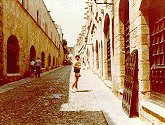
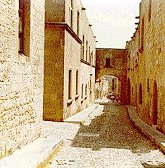
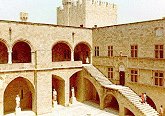
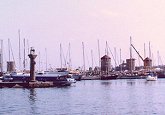

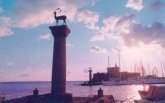
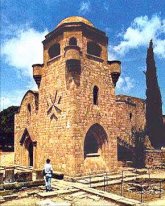
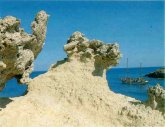
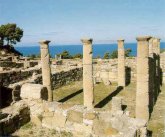


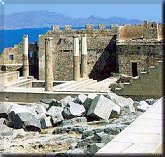
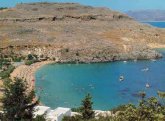
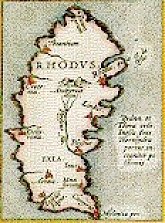
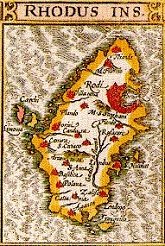
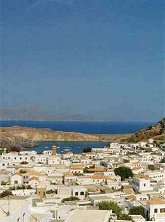
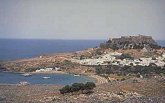
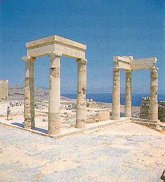

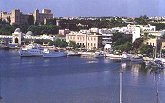
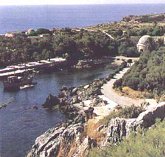
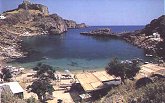

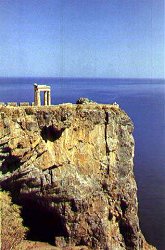
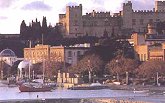

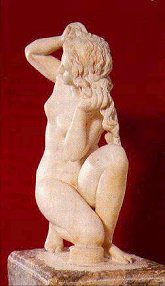
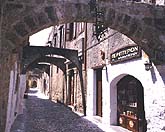
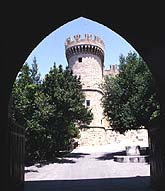
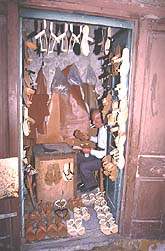
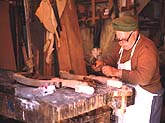
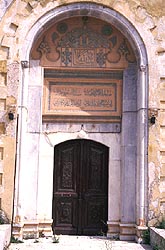
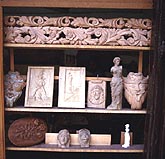
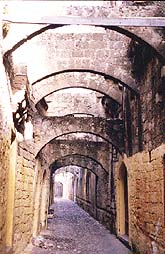
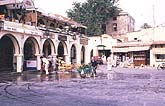
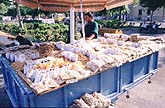
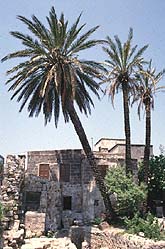
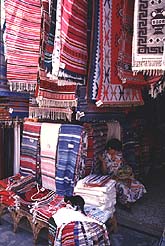
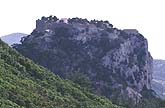
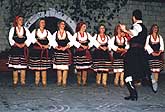
|







































